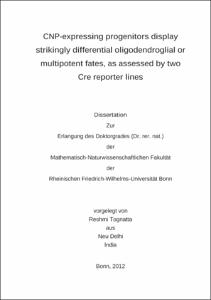Tognatta, Reshmi: CNP-expressing progenitors display strikingly differential oligodendroglial or multipotent fates, as assessed by two Cre reporter lines. - Bonn, 2012. - Dissertation, Rheinische Friedrich-Wilhelms-Universität Bonn.
Online-Ausgabe in bonndoc: https://nbn-resolving.org/urn:nbn:de:hbz:5n-30959
Online-Ausgabe in bonndoc: https://nbn-resolving.org/urn:nbn:de:hbz:5n-30959
@phdthesis{handle:20.500.11811/5429,
urn: https://nbn-resolving.org/urn:nbn:de:hbz:5n-30959,
author = {{Reshmi Tognatta}},
title = {CNP-expressing progenitors display strikingly differential oligodendroglial or multipotent fates, as assessed by two Cre reporter lines},
school = {Rheinische Friedrich-Wilhelms-Universität Bonn},
year = 2012,
month = dec,
note = {In this study, I employ a mouse line in which Cre is knocked-in for the 2’,3’ -cyclic nucleotide 3’ –phosphodiesterase (CNP) gene and compare the fates of CNP-Cre ex-pressing OPCs between two Cre reporters: Z/EG and ROSA26/EYFP. CNPase is found only in mature oligodendrocytes; therefore a subpopulation of “late” or relatively differ-entiated OPCs which have presumably made the decision to differentiate into oligoden-drocytes are labelled with this experimental strategy.
In the first section of this study, I present evidence of extensive oligodendrogliogenesis from CNP-Cre expressing OPCs in both experimental lines. I also show a small subset of reporter positive astrocytes and extensive neurogenesis in discrete regions of the CNP-Cre:ROSA26/EYFP line: ~12% of all EYFP+ cells in the ventral cortex represent an astrocytic phenotype with GFAP positivity and 55-70% reporter positive cells in the dorsal, ventral and piriform cortices are NeuN positive neurons. In striking contrast, no EGFP positive astrocytes or neurons are observed in the CNP-Cre:Z/EG line.
In the second section I report Cnp promoter activity-dependent reporter labelling in em-bryonic radial-glia (RG) like cells which are known to display multipotency. I suggest that OPCs remain committed to an oligodendroglial fate and do not display lineage plasticity; while oligodendroglial genes are switched on transiently in RG-like cells at extremely low levels, only to be detected by sensitive Cre reporters. I thereby show that fate mapping studies can be strongly biased by the choice of Cre reporter strains, result-ing in stark differences in the progeny of oligodendroglial precursors as observed in this study.
The last part of my thesis, is devouted to elucidating the functional role of the GluRB AMPA receptor subunit in influencing OPC physiology, by availing the GluRB floxed NG2creERTM:GluR-B2lox/2lox:ROSA26/EYFP mouse line. I demonstrate that removing the GluRB subunit from the OPC leads to a reduction in OPC proliferation in white matter regions. AMPA receptors are the principal mediators of glutamatergic signalling at the neuron-OPC synapse, and an insight into their effect on OPC development, as presented in this study, will further enhance our understanding of neuron-OPC cross-talk.},
url = {https://hdl.handle.net/20.500.11811/5429}
}
urn: https://nbn-resolving.org/urn:nbn:de:hbz:5n-30959,
author = {{Reshmi Tognatta}},
title = {CNP-expressing progenitors display strikingly differential oligodendroglial or multipotent fates, as assessed by two Cre reporter lines},
school = {Rheinische Friedrich-Wilhelms-Universität Bonn},
year = 2012,
month = dec,
note = {In this study, I employ a mouse line in which Cre is knocked-in for the 2’,3’ -cyclic nucleotide 3’ –phosphodiesterase (CNP) gene and compare the fates of CNP-Cre ex-pressing OPCs between two Cre reporters: Z/EG and ROSA26/EYFP. CNPase is found only in mature oligodendrocytes; therefore a subpopulation of “late” or relatively differ-entiated OPCs which have presumably made the decision to differentiate into oligoden-drocytes are labelled with this experimental strategy.
In the first section of this study, I present evidence of extensive oligodendrogliogenesis from CNP-Cre expressing OPCs in both experimental lines. I also show a small subset of reporter positive astrocytes and extensive neurogenesis in discrete regions of the CNP-Cre:ROSA26/EYFP line: ~12% of all EYFP+ cells in the ventral cortex represent an astrocytic phenotype with GFAP positivity and 55-70% reporter positive cells in the dorsal, ventral and piriform cortices are NeuN positive neurons. In striking contrast, no EGFP positive astrocytes or neurons are observed in the CNP-Cre:Z/EG line.
In the second section I report Cnp promoter activity-dependent reporter labelling in em-bryonic radial-glia (RG) like cells which are known to display multipotency. I suggest that OPCs remain committed to an oligodendroglial fate and do not display lineage plasticity; while oligodendroglial genes are switched on transiently in RG-like cells at extremely low levels, only to be detected by sensitive Cre reporters. I thereby show that fate mapping studies can be strongly biased by the choice of Cre reporter strains, result-ing in stark differences in the progeny of oligodendroglial precursors as observed in this study.
The last part of my thesis, is devouted to elucidating the functional role of the GluRB AMPA receptor subunit in influencing OPC physiology, by availing the GluRB floxed NG2creERTM:GluR-B2lox/2lox:ROSA26/EYFP mouse line. I demonstrate that removing the GluRB subunit from the OPC leads to a reduction in OPC proliferation in white matter regions. AMPA receptors are the principal mediators of glutamatergic signalling at the neuron-OPC synapse, and an insight into their effect on OPC development, as presented in this study, will further enhance our understanding of neuron-OPC cross-talk.},
url = {https://hdl.handle.net/20.500.11811/5429}
}






